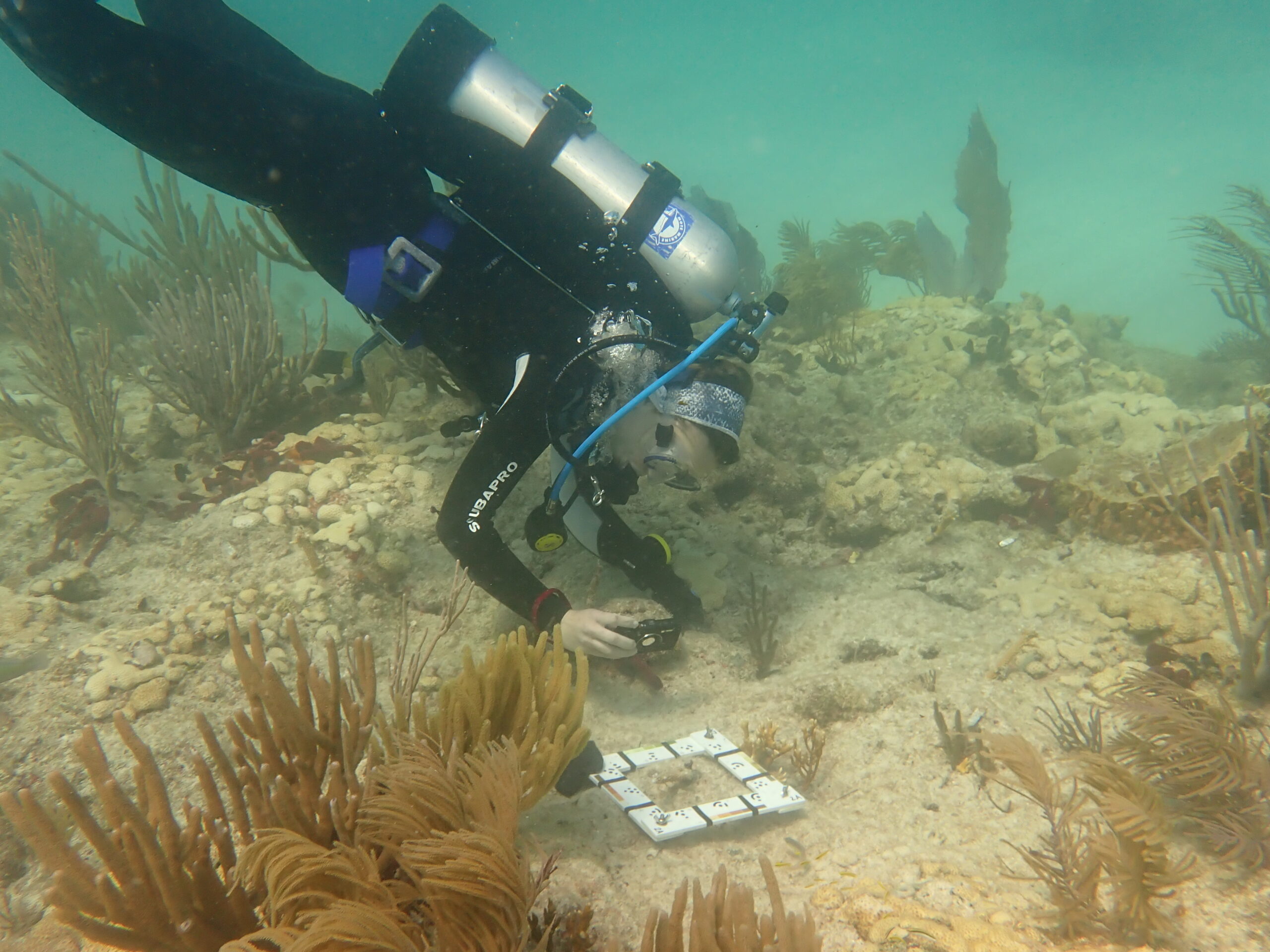A Devastating Summer for Coral Reefs–and How to Help Save Them
Carly Kenkel will never forget the summer of 2023.
 An assistant professor of biological sciences, Kenkel was recently named the Wilford and Daris Zinsmeyer Early Career Chair in Marine Studies in recognition of her work on coral genetics, which she has been researching for 15 years.
An assistant professor of biological sciences, Kenkel was recently named the Wilford and Daris Zinsmeyer Early Career Chair in Marine Studies in recognition of her work on coral genetics, which she has been researching for 15 years.
In June 2023, her team traveled to Florida to begin summer field research, as they’d done many times before. Kenkel and her collaborators have undertaken several transplant experiments, moving corals around the Florida Keys and the Dry Tortugas, island chains located between Cuba and the southern tip of mainland Florida. The corals are often sourced from partner restoration organizations like Mote Marine Lab, which grows coral in nearby “nurseries” to help restore reefs that have been damaged by climate change.
After transplanting the new corals, Kenkel and her students then collect data on previous years’ transplants, in part by photographing the corals and stitching the photos together to create 3D models. Once back at USC, the Kenkel lab can work with the models to take measurements of the corals. They combine these measurements with other data to help them determine how the corals’ genetic makeup and local environmental conditions affect shape, size, and survival, thereby shedding light on the corals’ utility for conservation and restoration projects.
Climate Change-El Niño Combination Triggers Unprecedented Damage
The summer of 2023, however, did not go as planned. Due to the combined forces of climate change and an emerging El Niño system, the waters around Florida experienced a warming trend so drastic and unprecedented that it rapidly wiped out almost all of Kenkel’s transplants.
“Just three weeks after our regular nine-month check up on the transplants in the Florida Keys, I had to send the students back to re-survey our sites because we were worried we’d have no chance to collect data otherwise,” Kenkel says.
The plan was to revisit the Dry Tortugas at the one-year interval because the location is too remote for frequent travel. This year, however, an emergency visit had to be arranged in September to capture data before all the coral transplanted in June were bleached or killed.
Circumstances were even more dire at the conservation nurseries.
“Our collaborators at Mote called us to say they were looking at a complete loss of their nursery, which sits a little closer to where the warmest waters are. They had to evacuate corals from the nursery to land-based facilities,” Kenkel says.
Overall, the corals in the region experienced approximately three times the heat stress they typically experience in any given summer. Reefs across the Caribbean Ocean fared similarly. While prior warm years in the Florida Keys have reached 8 degree heating weeks (a measure used to determine how frequently and for how long the ocean temperature exceeds the normal maximum), this year saw more than 20 degree heating weeks. According to Kenkel, we will have to wait until the peak of the southern hemisphere’s summer–in February or March–to know whether the warming in the Gulf of Mexico and the Caribbean foretell the start of a global event.
The Limits of Reef Recovery
As she considers the implications of what she witnessed, Kenkel’s primary concern is the long-term impact on coral reefs and their function. Reefs serve many purposes, both for marine species and for coastal residents. They are food sources, habitats, and nurseries for ocean wildlife; a food source for subsistence fishing communities; and breakwaters that help soften the blow of storms such as hurricanes.
Mature, healthy reefs consist of a mix of large corals, which take hundreds or even thousands of years to reach full size, and small corals that grow more quickly. If and when reefs grow back from extensive damage, small corals tend to dominate. The reduction in biodiversity and lack of large structures make the reefs less effective as food sources, habitats, and breakwaters. In other words, reefs may recover from catastrophic bleaching events, but they’ll never be the same.
Kenkel’s summer experience and its possible long-term impacts were top of mind this fall as she sat down for a conversation with the legendary Sylvia Earle, who visited USC as the Annenberg Center for Climate Journalism and Communication’s inaugural climate communicator in residence. Earle, the first woman chief scientist of the National Oceanic and Atmospheric Administration and the National Geographic Society’s first explorer in residence, has been named a Living Legend by the Library of Congress and the first Hero for the Planet by Time magazine, among many other accolades. She has been diving the world’s oceans since 1953 and cares deeply about the fate of our planet’s coral reefs.
As Kenkel and Earle spoke about Earle’s experiences, especially with regard to the changes she’s seen in coral reefs, Earle offered several key tips for those who want to help save these critical habitats from the kind of devastation Kenkel witnessed this summer.
Use Knowledge to Inspire Hope
“We need the planet to be thriving,” Earle says, yet we know that our own actions as “agents of change” are damaging the Earth’s systems and its ability to support human life. “But knowing that is cause for hope,” she says. “Imagine if we did not know the corals are in trouble, and therefore we’re in trouble.”
This knowledge–not only that the planet is changing, but also why it’s happening–can be discouraging. But Earle sees it as a cause for hope because, in order to identify solutions, we must first know what the problem is. Since we have that information, we can move forward to find meaningful answers to saving coral reefs and other systems that are crucial to the health of Earth and our fellow human beings.
Look, Don’t Take
Heat stress, of the kind Kenkel witnessed this summer, is not the only threat to coral reefs. “There’s a tight connection between nutrients, habits of fish, and all the other creatures that make a coral reef a coral reef,” Earle explains.
Overfishing and other human activities often damage both the reefs themselves and their surrounding ecosystems. By contrast, coral reefs that are protected from human impacts are structurally more robust, have healthier ecosystems, and are better able to resist the effects of climate change.
For this reason, Earle advocates an end to commercial fishing in coral reef environments. She also founded the organization Mission Blue to support the creation of no-take marine reserves around the globe. And restraint, she points out, doesn’t only benefit the oceans. When we reduce commercial fishing, which primarily feeds wealthy nations that have other food sources, we leave reefs intact for people who truly rely on them to survive.
I think it’s a really exciting time to be a kid, or a grownup. What we do now really matters.
Look for the Miracle of Life
It can be hard to overcome discouragement, inertia, or force of habit. Climate grief and anxiety can be paralyzing, creating a sense that there’s no way to turn the tide on the damage to our planet. Even if you want to help, you may not know where to start, or may struggle to speak out or change your behaviors.
In those situations, Earle recommends looking for what she calls “the miracle of life.” Even in devastating situations, she points out, some spark of life often survives. Although she has seen some species go extinct within her lifetime, she’s seen others reach the brink of extinction and then bounce back. Many reefs in Florida, the Caribbean, and the Indian Ocean have been bleached by climate change–but there are also patches of healthy corals left.
“There’s resilience within a diverse community, somebody who’s going to be able to withstand more than most of their neighbors. It’s like the story of the Lorax: one seed, maybe the trees can come back,” Earle says.
Any Skill Can Help
But what if you’re not a scientist like Kenkel, or you don’t have a platform as big as Earle’s? Can you still help? Absolutely, Earle says.
Almost any skill can be put to work in the service of saving coral reefs and helping our planet. Photographers, artists, filmmakers, and musicians can create works that speak to people’s emotions and motivate them to act. Students and community members can help researchers gather data. Journalists and communicators can help scientists share their findings with the public and combat misinformation. Elected officials and business leaders can enact policies that protect fragile ecosystems.
“The best way to address climate [change]? Look in the mirror. My kids ask, ‘What do you got?’ What makes you human?” Earle says. “Figure out something within the great array of solutions, how you can step up. I think it’s a really exciting time to be a kid, or a grownup. What we do now really matters.”
For the full conversation between Carly Kenkel and Sylvia Earle, watch the video above.



